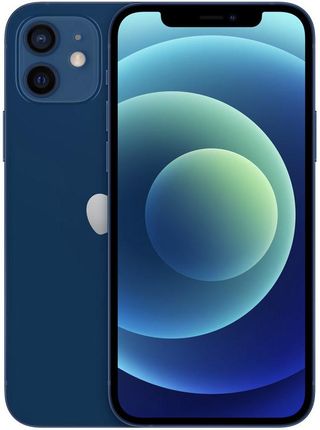Imagining a 5-inch iPhone 6
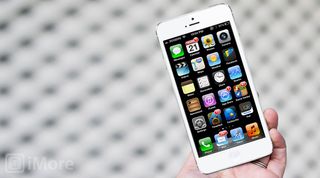
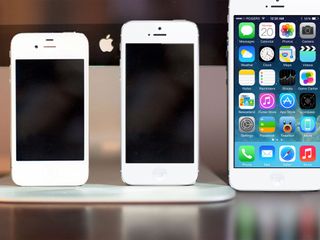
Never mind rumors of an awkwardly named 4.8-inch "iPhone Math", the concept of a much larger iPhone has been floating about ever since the realities of early LTE chipsets -- and the batteries that came with them -- forced Android and Windows-based competitors to break the size barrier. Before the 16:9 iPhone 5 was announced, I examined some of the different ways Apple could go to 4-inches. More recently, following the launch of the iPad mini and the Droid DNA, I took a quick look at how Apple could achieve a 1080p+, 440ppi+ phone, one that would sit between 4-inches and 7.9-inches.
But it's worth a deeper look. Because, when you're dragging hundreds of millions of users, hundreds of thousands of developers, and hundreds of... hundreds of accessory makers behind your platform, it makes turning on a dime hugely problematic. Small, incremental steps, with adjustment periods after each, is the prudent way to go. And that's exactly how Apple has handled the iPhone so far.
Update: How Apple could scale iOS to 5-inches
Apple introduced the now-standard 1x pixel density, 3.5-inches at 480x320 and 163ppi, with the original iPhone in 2007. They introduced the Retina 2x density, 3.5 inches at 960x640 and 326ppi, with the iPhone 4 in 2010. They introduced the 16:9 aspect ratio, 4-inches at 1136x640 and 326ppi, with the iPhone 5 in 2012. If -- an it's a big if, no pun intended -- Apple intends to offer a larger screen alternative one day, it makes sense they'd do it in the same way. Let everyone get used to 16:9, let developers update their apps and accessory makers update their products, and then take the next step. Whether that's in 3 years like the switch to Retina, or 2 years like the switch to widescreen, or 1 year if acceleration continues, keeping things grounded as you push previous limits, and balancing stability with change, is how you move a platform forward.
I still believe 2013 needs to be more about iOS and iCloud than new hardware, but putting that aside, and asssuming we've not seen the last or the largest iPhone screen Apple ever makes, what steps could they take to get to 5-inches?
5-inches at 2x
The first way Apple could go to, or at least get closer to, 5-inches is simply by increasing the physical size of the current iPhone 5 display and keeping the 1136x640 pixel count the same. That would result in larger pixels, however, meaning lower pixel density.
At 4 inches, the the 1136x640 iPhone 5 has the same pixel density as the iPhone 4 and iPhone 4S, or 326ppi. What happens if you stretch that out close to 5-inches? Interestingly, it goes to 264ppi. That's the pixel density of the Retina iPad. It's a density Apple already manufacturers, much like the shrunken iPad mini display was also a density Apple already manufactured, the 163 ppi of the original iPhone, iPhone 3G, and iPhone 3GS.
Master your iPhone in minutes
iMore offers spot-on advice and guidance from our team of experts, with decades of Apple device experience to lean on. Learn more with iMore!
Retina is a function of pixel density at distance. That's why, from 10-feet away, a reasonably sized 1080p television looks "Retina", and why the 264ppi iPad 4 looks as good from your lap as the 326ppi iPhone 5 does from your hand. Similarly, a 5-inch phone wouldn't need to be held as closely as a 4-inch phone. So, while it would certainly lose sharpness, there'd be some mitigation.
Developers and designers wouldn't have to create any new graphical assets to support a 5-inch iPhone at 264ppi. However, it would increase the size of existing interface, text, and other pixel-based on-screen elements and touch-targets, which could make them overly, borderline comically, large. (Except for people with visual accessibility issues who currently find the iPhone's interface elements and text too small to read comfortably.)
For videos and games, a scaled up screen is a plus. You could even shrink down a website or photo smaller to see more if it at the same physical size. Unlike to switch to the iPhone 5's 16:9 screen, however, there aren't any additional pixels. You're getting bigger, not more.
Going to 5-inches while staying at 2x could work, especially considering the step-by-step approach Apple's taken so far, but it's not ideal
5-inches at 3x

That's an example of, from left to right, of what happens when a display goes from standard, to Retina, has its size changed, or gets scaled by a non-integer amount (i.e. 1.5x). As you can see, it's fine in all cases but the last. That's the reason Apple went to 2x for Retina and not some arbitrary size -- it allowed them to maintain as much app compatibility as possible. When 1 standard size pixel becomes 4 Retina pixels (2x in each direction) everything still falls "on the grid" and stays nice and sharp.
Arguably, as densities get high enough, and displays far away enough, you no longer notice the blurring. But phones aren't held at arms length like a Retina MacBook Pro. If Apple wants to go closer to 5-inches, and add more pixels to do it, it makes sense they'd stick with multiples of the original screen size. So, after 2x, we have 3x. After 1136x640, we have 1704x960 which at roughly 5-inches is 391ppi. That's more pixels than 720p, and well past Retina.
Just like when Apple switched from 1x to 2x, a switch from 2x to 3x would mean developers and designers would need to create new @3x assets for their apps. Depending on how many graphics are in an app, that can be a lot of work.
The benefit is that you're not just getting bigger, you're getting more. Small text continues to look great, and when you zoom out, details on web pages or photos are still crisp.
On the downside, the more pixels you have, the more graphics power you need on the chipset to drive them, and the denser they get, the more LED you need to punch through and light them. That means more battery to drive them, and that's the reason the iPad mini isn't Retina.
Granted 1704x960 isn't 2048x1536 like the Retina iPad, but few people would want an iPhone anywhere nearly as thick and heavy as the Retina iPad either. (At least as it exists now...)
Going to 5-inches and increasing density to 3x feels like a double-step, but if the technology is in place to do it at the right lightness and thinness, it could also be the best compromise.
5-inches at 4x

That's how the various 5-inch iPhone options look when you compare them both in terms of pixel count (top) and physical scale (bottom), with an iOS standard touch-target grid overlay (44px). From left to right, the iPhone 5 (black), theoretical iPhone @3x (purple), theoretical iPhone @4x (red), theoretical iPhone with iPad display @2x (blue), with the HTC Droid DNA 1080p (green) thrown in for good measure.
Yes, HTC has made 1080p (1920x1080) phones at 440ppi, which while positively pornographic, show what's already out and on the market. If Apple decides it wants to exceed that the way the original Retina display exceeded other panels at the time, they'd have to skip 3x and go straight to 4x -- 2272x1280 at 522ppi.
It would require even more graphics processing power, more light, and more battery, and it would be absolutely batshit insane, but hey, we're considering all options here.
Going to 5-inches at 4x probably isn't something within the current realms of technology, economics, or reason, however.
5-inches using the iPad mini display
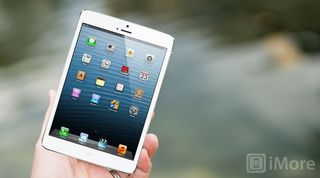
While I won't call them phablets -- or tablones -- devices that blur the boundary between phone and tablet continue to be released. However, they're typically larger than 5-inches. 5.5-inches and now 6-inches are the norm. Also, unlike the iPhone 5, which has a 16:9 aspect ratio, and previous iPhones, which had 3:2 aspect ratios, the iPad has a 4:3 aspect ratio. In other words, it's wide. 1024x768 at 5-inches works out to 256ppi. If it were technologically possible cram a 2x iPad Retina display in there, 2048x1356 at 5-inches works out to 512ppi.
On the plus side, it would unify the app ecosystem and let the iPhone run iPad apps. On the minus side, if an iPhone interface starts to look ridiculously large at 5-inches, an iPad interface would be ridiculously, likely unusably, small at that same size. Existing iPhone apps, letterboxed, would probably be okay if they filled something close to their current 4-inch size. iPad apps would be another story entirely. The iPad mini is probably represents the bottom end of tap-target size, and shrinking from 7.9 to 5 would necessitate a stylus. The size of a toothpick.
Going to 5-inches by switching to an iPad display is a non-starter.
5-inches at some arbitrary or standardized pixel count
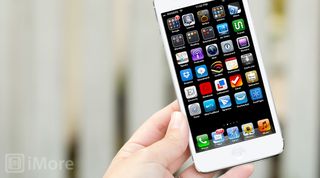
Other options include Apple switching from the traditional iPhone screen size, and its more modern multiples, to something arbitrary -- keeping the same 326ppi and just adding pixels to fill 5-inches -- or switching to a standard display size like 720p or 1080p.
To hit 5-inches at 326ppi, Apple would need to go to 1420x800 for the iPhone display size.
720p translates into 1280x720 and at 5-inches, that's 294ppi. 1080p translates into 1920x1080 and at 5 inches, that's 441ppi.
Neither approach seems to offer Apple any advantage over pixel trebling or even quadrupling, would result in scaled apps and interface elements falling off the grid and looking fuzzy, and create huge compatibility headaches in general for Apple, developers, and users.
Going to 5-inches at some arbitrary on standardized pixel gives you some of the benefits but all of the drawbacks and also seems like a non-starter.
4.5- or 4.8-inches

If Apple considers a screen size of 4.5- or 4.8- instead of 5-inches, the basic premises stay the same. Either way, if Apple stays at 2x, interface elements wouldn't be blown up as much at 4.5- or 4.8- as they would at 5-inches, nor would density decrease as much. At 4.5-inches the current 1136x640 display would be 290ppi, and at 4.8-inches it would be 272ppi. 3x would be 435ppi or 408ppi. 4x would be a silly 560ppi or 543ppi.
Given that, going to 4.5- or 4.8-inches could be a more reasonable alternative to 5-inches.
Yeahbuwhy?!
Apple has said as recently as the iPhone 5 introduction that they don't want to make a screen that the average person can't reach, corner-to-corner, with the thumb of one hand. And just like never making video iPods, or 7-inch tablets, Apple absolutely means that. Until they don't. That's why you can never say never with Apple.
For the sake of this discussion, lets assume there's a larger screen iPhone in the labs or sketched out on a napkin, or something. One handed ease of use is a feature that can be tackled in both hardware and software. Right now Apple's handling it in hardware. BlackBerry 10 will be tackling it in software, using corner gestures to allow for more navigation with less thumb travel. (Apologies for the gobsmacking cheesiness of this video, it's the only BlackBerry Flow example I could find.)
Apple's a really smart software company. If they ever go to 5-inches, they'll figure it out. (Hell, they'll invent it. But will they ever go to 5-inches? Not surprisingly, the go-to-market for a bigger iPhone echo and mirror those for a smaller iPad. From my previous post:
[For some customers, 4-inch iPhone] still isn't big enough.For some of those, size sells. Imagine you walked into a Big Box retailer and all the television sets, from 32- to 70+-inches all cost pretty much the same thing. Imagine the 70+-inch television, or even the 102-inch television, cost less than the 32-inch one. Thanks to carrier subsidies and agendas, that's the current situation for the iPhone. Customers walk into carriers or retailers and see the $199 iPhone on the shelf alongside 4.5- to 5-inch or bigger Android phones and Windows Phones. Bigger equals better, so they buy bigger.For the rest, size matters. Either their eyes require bigger interface elements to easily use, their motor skills appreciate more room to move around, or they simply want a bigger screen to do bigger things with. Bigger web. Bigger videos. Bigger games. They might even want something approaching mini-tablet size, and would rather have a big phone than a small phone and a tablet. Bigger is better, so they buy bigger.For both, even if they'd prefer an iPhone in many ways, the screen size is what they see, or what's more important to them than anything else. And because of that, neither of those customers is choosing the iPhone.
Or more simply put, if people are buying massive amounts of premium large-sized handsets, Apple could one day decide they'd rather those people buy premium Apple-made large-sized handsets than competing brands. If Apple sees value in increasing the scope of their addressable market, and thinks it will help them make a better product and sell more units, then that's why Apple would add a bigger iPhone to the mix.
And that's when as well.
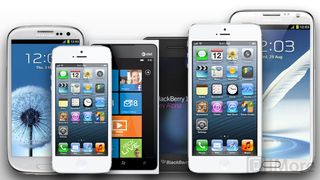

Rene Ritchie is one of the most respected Apple analysts in the business, reaching a combined audience of over 40 million readers a month. His YouTube channel, Vector, has over 90 thousand subscribers and 14 million views and his podcasts, including Debug, have been downloaded over 20 million times. He also regularly co-hosts MacBreak Weekly for the TWiT network and co-hosted CES Live! and Talk Mobile. Based in Montreal, Rene is a former director of product marketing, web developer, and graphic designer. He's authored several books and appeared on numerous television and radio segments to discuss Apple and the technology industry. When not working, he likes to cook, grapple, and spend time with his friends and family.
Most Popular



